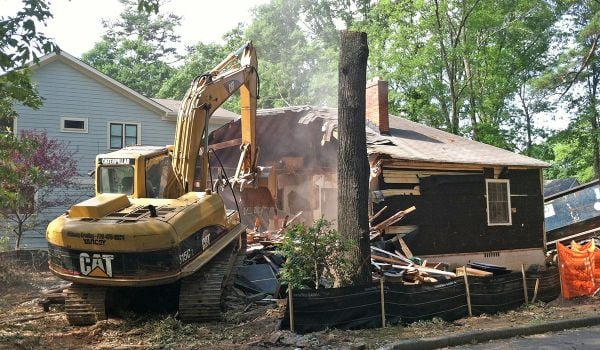Charlotte’s Cherry neighborhood was established in 1891 as an affordable community for working-class African-Americans, a place to raise a family. Unlike other neighborhoods in the city built specifically for black people during the era of segregation, Cherry didn’t experience the influx of teardown marked by redevelopment in the 1960s and 1970s. Now, the story of renewal is changing. Developers and affluent homeowners have moved in, and longtime residents fear that rapid growth and displacement will erase Charlotte’s oldest and last-standing historic black community. How the city of Charlotte might step up to protect the neighborhood from looming gentrification — and address the much larger challenge of housing affordability across the city — remains to be seen.
With its proximity to Uptown (the colloquial reference to the city’s downtown area) and good access to public transportation, post-2008 recession Cherry has been an easy target for developers, who are profiting from an abundance of vacant lots and low-cost homes. In the last decade, 1920s bungalows priced at $200,000 have been replaced with $600,000 California-style single-family homes purchased by wealthy newcomers, many of them white. The shift predates the recession though. UNC Charlotte’s Urban Institute reported demographics last year that put Cherry’s population at 57.3 percent white and 37.4 percent black. Based on 1990 census data, the black population in Cherry about 25 years ago was 66 percent black. By 2000, that number had dropped to 55 percent.
“Most of the neighborhood is privately owned and zoned for single-family residential. We have little to say about the redevelopment of older homes or vacant properties, which makes regulating development difficult,” says Kent Main, a planning coordinator with the city of Charlotte. “Gentrification is a difficult thing because the people that own houses in the area have the right to sell their property to developers or build bigger without respect to the character of the community.”
Residents regularly voice their concerns at city council meetings about allowing development that doesn’t mirror current neighborhood aesthetics. Worries are fueled too by prior controversial zoning decisions and development projects. Cost burdened by rising rents, they’re also concerned with the threat of being pushed out entirely.
Cherry’s not alone in this. Property taxes and displacement have been on the rise throughout Charlotte, where neighborhoods in the urban core have been transformed by the advent of luxury condo high-rises and commercial development.
Yet residents looking for protection against new market-housing construction in their formerly working-class neighborhoods are largely out of luck. The city has very few tools to actively force developers to set aside units to sustain affordable or “workforce” housing for the benefit of lower-income individuals and families.
“There’s no force of law requiring developers to include affordable housing units within their plans, which means that the city’s hands are tied [as it relates to mandatory inclusionary zoning],” explains Mary Newsom, associate director of urban and regional affairs at UNC Charlotte’s Urban Institute.
Mandatory inclusionary zoning policies adopted in New York and San Francisco are a critical part of overall efforts to increase the supply of affordable units within the overall mix of housing stock in those cities. In return, developers get tax abatements or other concessions.
In 2013, Charlotte introduced a Voluntary Mixed Income Housing Development Program to provide density bonuses. Developers could build more apartments than zoning allowed if they also included units intended for lower-income renters. It remains untouched.
Inclusionary zoning is politically dangerous territory in North Carolina. The cities of Davidson, Chapel Hill and Manteo are the only places to have independently worked such policy into housing ordinances. Last October, two developers in Davidson sued the city, which requires that 12.5 percent of new developments in subdivisions be set aside for “affordable” housing. The parties reached a settlement that required developers to pay $143,100 in lieu of providing low-cost homes within the subdivision. Charlotte’s current system is partly to blame for developers failing to take advantage of the voluntary program. Instead they rely on their power to get zoning amended on a case-by-case basis in council, eliminating the need to spend additional money on affordable units.
For example, last September, city council initially voted down the development of a mixed-use property on the Cherry/Midtown border that would include 225 hotel rooms, 300 apartments, 3,000 square feet of commercial space and a parking lot.
Cherry residents protested the plan, triggering a requirement on the books that nine of the 12 council members vote in favor of the zoning request in order for it to pass. Several city council members expressed concern that the property, proposed at 106 feet, was too tall and dense for the residential neighborhood. Additional arguments against the project highlighted that the development deviated too far from the Midtown-Morehead-Cherry area plan made in 2012, which calls for better streetscaping and more residential space.
A week after being voted down, the development was back on the agenda and approved — with the building reduced to 100 feet. The community petition against the development had been basically voided after the N.C. Senate repealed the petition law. No longer can the objections of enough Charlotte community members force the requirement of a supermajority vote on city council for a new development. The move further removes control of neighborhood development from residents’ hands.
City Councilwoman Patsy Kinsey, who has been a vocal opponent of the mixed-use development project and was the only council member to vote down the approved rezoning petition in the final tally, says city council needs to be much more discerning about rezoning approvals and the changing aesthetics of the Cherry neighborhood.
“We’re continuing to lose affordable housing, not just subsidized housing, for just regular working people,” she says, “especially as we are rezoning properties closer to town. We have to be careful.”
In Cherry, the responsibility of affordable housing has fallen largely on the Charlotte Housing Authority and rezoning approvals by city council. After securing $1.2 million from the Charlotte Housing Trust Fund, in addition to over $800,000 in tax credits from the state, CHA plans to redevelop currently battered Tall Oaks public housing from 50 units into 81. CHA is also seeking approval to build a 200-unit, income-restricted complex in the neighborhood.
The city also taps the housing fund, paid for by voter-approved bonds, to help developers finance projects in conjunction with the tax credits they receive from the state, to boost affordable housing units. Over the next two years, this fund is set to help realize over 300 new units of affordable rentals scattered in the Cherry, Belmont and Whitehall-Ayrsley neighborhoods. The city’s goal is to create over 5,000 affordable units by 2020.
But that might not be enough for Charlotte and its intense population growth and development. HUD data indicate a need for over 34,000 housing units across the Charlotte-Mecklenburg area affordable to families at or below 50 percent of the median area income.
“The city recognizes the need for diverse housing options, and we realize more broadly that Charlotte is a growing community, and we want it to be place where all people can thrive,” says Pam Wideman, deputy director of neighborhood and business services with the city of Charlotte. “We’re in the infant stages of working through an affordable housing plan, and working with HUD to consider what projects and solutions we can use to make an impact at the granular level to identify and address affordable housing needs.”
Sam Gunther, director of policy and advocacy at the North Carolina Housing Coalition, says Charlotte might look to Raleigh’s plan, approved by city council last October, for direction on developing an aggressive strategy. Intended to guide Raleigh’s affordable housing initiatives over the next five years, the plan calls for setting aside land for affordable housing development near transit centers, revitalizing downtown communities, and creating accessible funds to supply forgivable loans for the rehabilitation of affordable units in fast-developing areas. (To pay for the estimated $90 million of investment over the next five years, Raleigh plans to use housing bond funds and HUD money; the city has yet to finalize the budget.)
“The problem isn’t that our cities lack resources. That’s not the case in Charlotte or Raleigh,” says Gunther. “The challenge that these cities face is how to properly leverage these new resources so that everyone is benefitting.”
The Equity Factor is made possible with the support of the Surdna Foundation.

Sherrell Dorsey is a social impact storyteller, social entrepreneur and advocate for environmental, social and economic equity in underserved communities. Sherrell speaks and writes frequently on the topics of sustainability, technology and digital inclusion. Her work has been featured in Black Enterprise Magazine, Triple Pundit and Inhabitat.
Follow Sherrell .(JavaScript must be enabled to view this email address)
















